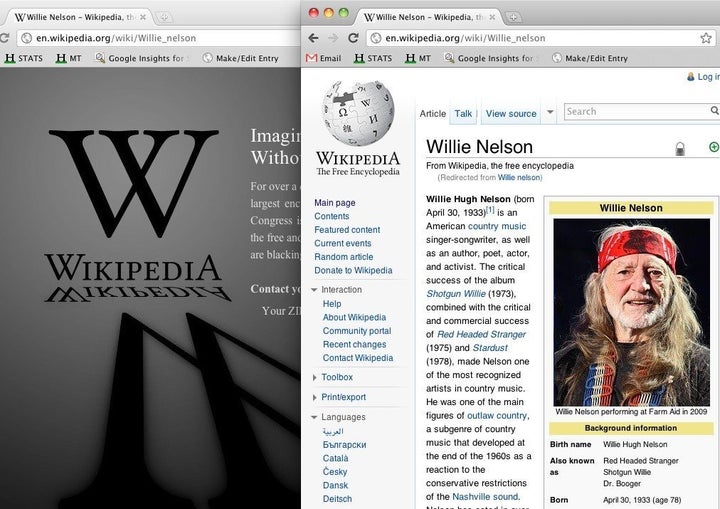
If you've attempted to visit one of the 3.8 million articles in the English-language version of Wikipedia today, then you already know that the site has been "blacked out."
In protest of the proposed Stop Online Piracy Act (SOPA) and PROTECT IP Act (PIPA), two controversial bills making their way through congress, Wikipedia has been "blacked out" since midnight Wednesday. When a user tries to visit a page, a black screen with the words "Imagine a World Without Free Knowledge" appears, blocking all other content. The blackout page also has information about SOPA and PIPA, and how user can get involved in protesting the bills.
According to Alexa, Wikipedia is the sixth most-visited website in the United States, so the blackout is certainly affecting millions of people.
But, as with any sort of barrier, there are ways around it. In fact, Wikipedia has said it is still possible to read the site's English-language articles during the blackout.
"Our purpose here isn't to make it completely impossible for people to read Wikipedia," the site notes, "and it's okay for you to circumvent the blackout. We just want to make sure you see our message."
So, keeping Wikipedia's message in mind, here are five ways to get around the Wikipedia blackout:
1. Go Mobile:
During the blackout, Wikipedia will remain available on smartphones and some mobile browsers. The Telegraph's Matt Warman notes that although Wikipedia apps on iPhones and Android devices work, the iPad runs regular Wikipedia and is thus blacked out.
Don't have a mobile device? Don't worry -- you can access the mobile site at any computer by visiting http://en.m.wikipedia.org/.
2. Append the URL:
A basic workaround offered by Wikipedia is perhaps the easiest fix: simply paste "?banner=none" (without the quotation marks) after the URL of any blocked page. Once the suffix is pasted, simply hit enter and, voilá, there's your article.
3. The "Escape" Method:
Sarah Maslin Nir notes in The New York Times that users who are quick with their fingers can press the "Escape" button on their keyboard just before a page fully loads. This will disable the "blackout" page from completely loading and obscuring the article.
"Timing the maneuver exactly right may take a few tries," she writes. We can attest to that.
4. Run Javascript Code:
This one is a bit more complicated than the above methods, but it's still effective in preventing the "blackout" page from fully loading. Go to your article and paste the following code in your browser:
javascript:void(document.getElementById('content').style.display='block');void(document.getElementById('mw-sopaOverlay').style.display='none');
(Note: some browsers will automatically erase the word "javascript" when it's pasted into the navigation bar, so you may have to manually type "javascript" into the code.)
5. Tweet It!
NPR, the Guardian and the Washington Post are trying to answer your questions. Simply send a tweet with hashtag #altwiki, and a representative from one of the organizations or a member of the public will try to give you an answer.
How are you surviving without Wikipedia? Are you using one of the above workarounds? Another one? Let us know in the comments!
Click here for more about SOPA and PIPA, and click here to learn what other sites are doing to protest the proposed legislation.
If you're interested in getting involved in the SOPA/PIPA protests, SopaStrike.com offers instructions on how to black out your own website. You can also let your voice be heard by clicking one of the links below.